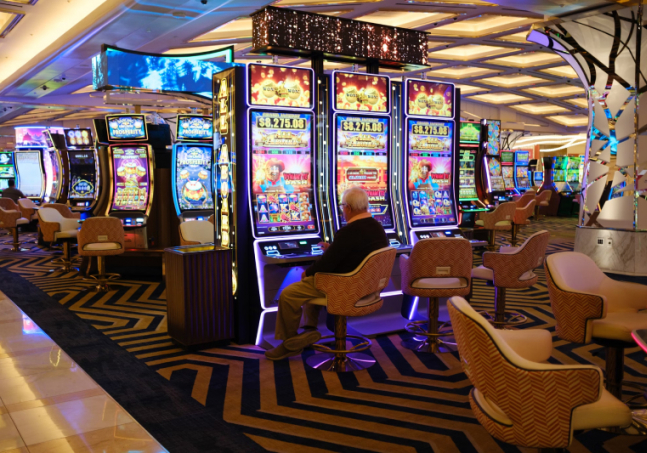Slot volatility, or variance or risk level, is a fundamental concept that shapes your entire slot gaming experience. While casual players might focus on themes and graphics, understanding volatility provides crucial insight into how a game behaves, how often it pays, and the potential size of those payouts.
This article will explain slot volatility more clearly, helping you make more informed decisions about which games suit your playing style, risk tolerance, and bankroll management strategies.
What Is Slot Volatility?
Slot volatility refers to how a slot game pays out over time, specifically regarding the frequency and size of wins. In simple terms, volatility assesses the risk level of playing a particular slot game. Unlike other metrics, volatility directly affects your experience during gameplay, influencing whether you will experience frequent small wins or occasional large payouts.
However, slot games typically fall into one of these volatility categories:
- Low Volatility Slots: Deliver frequent wins, though typically smaller in size. These games provide steady, consistent payouts that help maintain your bankroll over longer sessions.
- Medium Volatility Slots: Offer a balanced approach, combining smaller frequent wins and occasional larger payouts. They represent the middle ground between steady play and big-win potential.
- High Volatility Slots: Feature less frequent wins but offer the potential for significantly larger payouts when they do occur. These games can lead to longer losing streaks punctuated by more substantial wins.
- Extreme Volatility Slots: Provide even rarer wins with the potential to be very substantial, creating an even higher risk-reward proposition.
- Insane Volatility Slots: Represent the highest possible volatility setting, where wins are infrequent but can be enormous when they occur. These slots, often created by providers like Nolimit City, offer the most significant potential for staggering wins alongside considerably higher risk levels.
What is the Science Behind Slot Volatility?
Slot machine behavior is not purely based on random chance; sophisticated mathematical models govern it. Modern slots utilize Random Number Generators (RNGs) to ensure that each spin is an independent event unaffected by previous outcomes.
Behind the scenes, game developers create complex probability distributions that dictate how often specific symbol combinations will appear. High volatility slots are designed with mathematical models that deliver less frequent but larger wins, while low volatility slots have models that favor regular, smaller payouts.
Game designers make precise calculations to establish a slot's volatility index, which measures the variance in payback percentage during a gambling session. Games with higher volatility indices experience greater fluctuations in their payback percentages compared to games with lower volatility indices during typical play sessions.
What is the difference between Volatility vs. RTP?
Players often confuse volatility with Return to Player (RTP), but these are two distinct concepts that work together to shape the overall slot experience:
- RTP (Return to Player): This is expressed as a percentage, typically ranging from 90% to 96%. RTP indicates the amount of money wagered that is theoretically returned to players over the long term. For example, a slot with a 95% RTP is programmed to return $95 for every $100 wagered over thousands of spins.
- Volatility: This describes how the RTP is distributed, determining whether players will experience frequent small wins or rare large payouts.
Two slot games can have the same Return to Player (RTP) percentages but exhibit vastly different levels of volatility. For example, two slots with a 96% RTP could provide entirely different experiences: one may offer steady, small wins (low volatility), while the other might deliver infrequent but significantly larger payouts (high volatility).
Understanding this distinction is crucial; RTP indicates expected long-term returns, while volatility describes how those returns will be experienced during actual gameplay.
How Volatility Affects Your Gameplay
Slot volatility significantly affects various aspects of your gaming experience:
- Bankroll Management
Your approach to bankroll management should change based on the volatility of the games you play. High-volatility slots typically require a larger bankroll to endure potential lengthy losing streaks, while low-volatility games allow for longer play with smaller budgets. For instance, if you’ve encountered a streak of bad luck and have limited funds left, switching to a low-volatility game could help you maximize your remaining spins and potentially recover some losses.
On the other hand, if luck has been on your side, having extra funds might present an opportunity to try higher-volatility slots and pursue bigger payouts.
- Player Experience
Volatility directly impacts your emotional experience when playing slots. Low-volatility games provide more consistent feedback through frequent wins, leading to a more relaxed and prolonged gaming session. In contrast, high-volatility slots offer a different kind of thrill, as players must navigate through losing streaks, which can be followed by the excitement of potentially substantial wins.
- Win Size and Frequency
Perhaps the most evident effect of volatility is on how often you win and the amount of those wins. Low-volatility slots may pay out every few spins, but typically in smaller amounts that simply extend your playing time. Conversely, high-volatility games may result in long stretches without significant wins, but when they do pay out, the winnings can substantially increase your bankroll.
How to Identify a Slot's Volatility Level
While many slot games do not explicitly indicate their volatility, there are several methods to help you assess a game's risk level:
- Examine the Paytable
The paytable of a slot game provides valuable insights into its volatility. Games that feature high maximum payouts, significant disparities between high-symbol and low-symbol payouts, or substantial multipliers often suggest higher volatility.
- Analyze Bonus Features
The type of bonus features a slot offers can also indicate its volatility. Games that include features with massive multipliers, progressive jackpots, or high-risk bonus rounds usually have higher volatility. In contrast, slots that provide more consistent but smaller bonus payouts typically represent lower volatility.
- Play in Demo Mode
Testing games in free play or demo mode allows you to observe payout patterns firsthand. If you notice frequent small wins, you are likely playing a low-volatility game. Conversely, if wins are rare but can be substantial when they do occur, you are probably dealing with higher volatility.
- Research Game Information
Some developers, such as NetEnt, Play'n GO, and Pragmatic Play, provide explicit volatility ratings in their game information. Additionally, reputable casino blogs and review sites often include assessments of volatility in their slot reviews.
Strategies for Playing Different Volatility Slots
Adapting a playing approach based on volatility can enhance your overall experience:
Low Volatility Strategies
- Ideal for casual players seeking extended entertainment
- Perfect for smaller bankrolls or conservative play
- Consider using minimal bet sizes to maximize play time
- Good choice when recovering from losses or seeking steady gameplay
- Focus on enjoying the gaming experience rather than chasing massive wins
Medium Volatility Strategies
- Provides a balanced approach suitable for most players
- Offers flexibility to adjust strategy based on session results
- Consider starting with these games before moving to higher or lower volatility based on results
- Allows for reasonable win potential without excessive risk
High Volatility Strategies
- Requires larger bankrolls to withstand potential losing streaks
- Better suited for players specifically seeking significant win potential
- Demands patience through dry spells
- Consider higher bet sizes when pursuing bonus features, as these often deliver the most substantial payouts
- Best approached with a long-term mindset rather than expecting immediate results
Matching Volatility to Your Playing Style
In conclusion, understanding slot volatility helps you make informed decisions that align with your goals, preferences, and resources. Whether you seek steady entertainment, balanced gameplay, or the thrill of chasing substantial payouts, knowing about volatility provides a framework for selecting games that match your desired experience.
It's important to remember that volatility represents statistical averages over thousands of spins, not guarantees for individual sessions. In the short term, anything can happen; you might hit several big wins on a high-volatility slot or experience a prolonged dry spell on a low-volatility game. However, over time, the underlying mathematics will guide the results toward their expected patterns.
The best approach combines an understanding of volatility with thoughtful bankroll management and realistic expectations. By aligning these elements with your personal preferences, you can create a more enjoyable and potentially rewarding slot gaming experience. Whether you prefer the steady rhythm of low-volatility games or the high-risk, high-reward nature of more volatile slots, knowing what to expect will help you choose games that deliver the right balance of entertainment and winning potential.








.jpg)
.jpg)
.jpg)







How does it work?
Locate and discover worldwide casinos
Find their promotions, events and enjoy exclusive deals
Good luck!